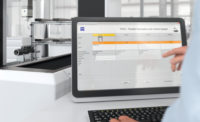Taking Flight: Aerospace Solutions Allow Accuracy with Uncompromised Productivity

Wilbur and Orville Wright began experimenting with the idea of flight in 1899, and their first aircraft famously took flight in 1903. “It was the Wrights' genius and vision to see that humans would have to fly their machines, that the problems of flight could not be solved from the ground,” according to the National Park Service.
A little more than twenty years later, Charles Lindbergh flew across the Atlantic in 1927. According to the New York Times front-page coverage of his historic solo flight from New York to Paris, Lindbergh “ate only one and a half of his five sandwiches” during the flight and also briefly fell asleep.
While planes have gotten exponentially more complex, I think we can agree that a sleeping pilot doesn’t sound wise. But a safe flight depends on a host of technology, and aerospace metrology solutions continue to advance.
Stephanie McCartan of Carl Zeiss Industrial Metrology explains why aerospace trends are all about quality.
“The topic of our aerospace segment is improving productivity without sacrificing quality,” McCartan says. “We’re seeing OEMs consolidate their supply chain. This puts pressure on the supply chain to adopt tools and strategies to be more competitive.”
“Planes are staying in service longer, and being maintained longer,” she adds. “We’re seeing new technologies in the manufacturing process. Additive manufacturing is being explored for maintenance and aircraft components. It’s really interesting to see the research being done.”
For example, she mentions that additively manufacturing individual turbine blades could be more cost effective. McCartan works on the 3D scanning portfolio at ZEISS along with newer technology for high speed visual inspection, both of which have a big stake in aerospace industry.
While quality inspection is universal across manufacturing, aerospace does bring some unique aspects to the process. In addition to the specific standards, the parts involved require a different approach.
“One of the reasons metrology is so important in aerospace is the very distinct and unique part geometries and assemblies, for example, blades,” McCartan says. “This can mean specialized software or modules, or for some of the OEMs, homegrown software for a blade. As a metrology solutions provider, it’s important to be flexible and help our customers apply the data for the way they need.”
Know Your Application
If a manufacturer needs to determine the best inspection technology for their application, the first step in the process is understanding the application. Rather than just giving a quote for a machine—which may not be the best choice of equipment—the team will try to understand what it will be used for.
The solution could range from programming support and optimizing a customer’s existing software to looking into new fixturing options to simply improving existing solutions. New sensors and accessories are on the rise, McCartan notes.
“The big trend is using optical sensors to reduce inspection time and alignment time.”
For example, a CMM might have a range of sensors on it, such as contact or optical. Now it’s possible to use one program on one machine.
The integration of automation and robotics is another area where being able to measure a range of parts in one setup can be critical. Using a pallet system, a company might have several of the same part. By using a fixture in grid pattern, it’s possible to measure all of these parts in one setup.
As with any project, balancing accuracy and speed is the goal. “Oftentimes, the quality lab can be seen as a bottleneck,” McCartan says. To combat this, customers want to be able to cycle parts through faster.
What to Look For
If you’re in the market for new equipment, McCartan says it’s important to know your application well and be able to communicate your needs. And with so many options today in terms of hardware and software—just one example of how much the industry has changed since the Wright brothers—vetting the equipment is important.
In every situation, customers can’t sacrifice accuracy for speed.
“Customers understand the minimum accuracy they need,” McCartan says. “What it comes down to is who can provide the fastest solution. The big thing is whatever we can do is to improve productivity, without sacrificing quality. Sure, you can make something really fast, but is the quality there?”
It’s difficult to say what 2120 will bring in terms of aerospace—will we all be traveling to Pluto?—but looking ahead to the not-so-distant future, the trend is noncontact technologies.
“The trend has already started for noncontact technologies in aerospace,” McCartan says. “I really see these being pushed and developed further. Some of these might be surface scanning, visual, X-ray technology.”
In addition to technology trends, the other trend is speed. “We can do things very quickly with optics that oftentimes is faster than a tactile or contact inspection method. For example, with CT, we can see the internal geometries of a part, our manufacturing processes are becoming so advanced, with what we’re able to make there are endless possibilities. The challenge is how do we measure them?”
Looking for a reprint of this article?
From high-res PDFs to custom plaques, order your copy today!







